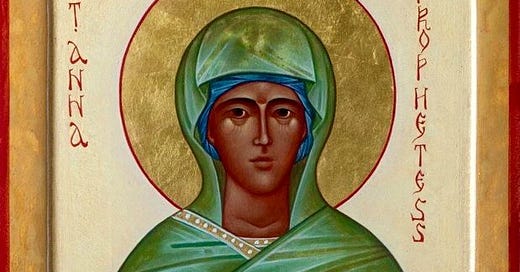When Joseph and Mary presented baby Jesus in the temple, the prophet Anna was there. This elderly widow “never left the temple but worshiped night and day (Luke 2:37). When Anna saw the baby Jesus, she did something that would become the apostles’ modus operandi a generation later, after the resurrection:
"Coming up to them at that very moment, she gave thanks to God and spoke about the child to all who were looking forward to the redemption of Jerusalem." (Luke 2:38)
Notice three things about Anna:
Verse 36 introduces her as a prophet (προφῆτις/profētis)
She's "in church," the temple, the holiest place
Proclaiming to everyone that Jesus is the redeemer.
Specifically, Anna “spoke about the child to all who were looking forward to the redemption of Jerusalem.” The NIV is translating λαλέω (laleō) as “speak.” The word can carry the sense of conversation or declaration. It’s the word translations like the NIV and ESV use for “teach” in Titus 2:1: “You, however, must teach (λάλει) what is appropriate to sound doctrine.” It describes the preaching of the gospel in Acts 11:20 …
But there were some of them, men of Cyprus and Cyrene, who on coming to Antioch spoke (ἐλάλουν, past tense of λαλέω) to the Hellenists also, preaching (εὐαγγελίζομαι/euangelizomai) the Lord Jesus. (ESV)
This is what the prophet Anna is doing in Luke 2, telling everyone at the temple that their hope for redemption lies with the baby Jesus. Decades later, Peter and the apostles will do the same thing in the early days of the church. We see this on the day of Pentecost, but it doesn’t stop there. After the apostles are jailed, an angel frees them and says, “Go, stand in the temple courts,” he said, “and tell the people all about this new life” (Acts 5:20, NIV. “tell” is another form of λαλέω). The chapter ends:
Day after day, in the temple courts and from house to house, they never stopped teaching and proclaiming the good news that Jesus is the Messiah (Acts 5:42)
The movement that spread from house to house began at the temple with the apostles, who made it their home base for gospel proclamation, but it was prefigured by a prophet named Anna decades before.
Richard Bauckham notes one more thing about Anna in Gospel Women: she is “of the tribe of Asher” (Luke 2:36). This is an important point because it speaks to the mission of Jesus to fulfill the hope of all Israel, not just the tribe of Judah. Backhaum writes:
“As a descendent of the exiles of the tribe of Asher, Anna ensures that the community represented in the narrative is Israel as a whole, northern tribes as well as southern, exiles as well as inhabitants in the land. She ensures that the messianic hopes represented include those of the northern tribes and the exiles.”
Jesus will later choose twelve male Israelites to make the same point. As symbols of the twelve tribal patriarchs, their presence with Jesus said, “Messiah is here — we are so back!” Once again, Anna is a trendsetter, prefiguring something that the ministry of the twelve will continue. When we tell the Christmas and Epiphany stories, let’s remember to let Anna have her say.





Excellent! I was not aware of Anna setting the precedent for the apostles or the translations of λαλέω. Then again, I didn't do so well in NT Greek. :) Thank you for sharing!
I also think it's interesting that, as a widow, Anna represents the recurring trio of the marginalized and powerless in the OT--foreigner, fatherless, and widow--that were to be shown compassion and cared for. Widowhood was also a liminal state that, in the OT, signals some kind of intervention by God, usually in a miraculous way. She is a fascinating character indeed!
I learned so much reading this, as always! I've always loved Anna, and you've given me more reason now.